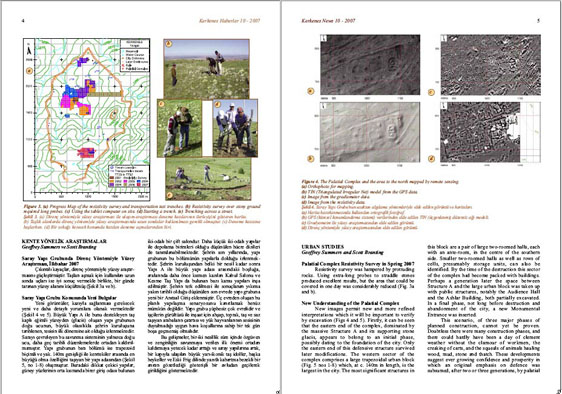| |
URBAN STUDIES Geoffrey Summers and Scott Branting Palatial Complex Resistivity Survey in Spring 2007 Resistivity survey was hampered by protruding rocks. Using extra-long probes to straddle stones produced excellent results, but the area that could be covered in one day was considerably reduced (Fig. 3a and b). New Understanding of the Palatial Complex New images permit new and more refined interpretations which it will be important to verify by excavation (Figs 4 and 5). Firstly, it can be seen that the eastern end of the complex, dominated by the massive Structure A and its supporting stone glacis, appears to belong to an initial phase, possibly dating to the foundation of the city. Only the eastern end of this defensive structure survived later modifications. The western sector of the complex comprises a large trapezoidal urban block (Fig. 5 nos 1-8) which, at c. 140m in length, is the largest in the city. The most significant structures in this block are a pair of large two-roomed halls, each with an ante-room, in the centre of the southern side. Smaller two-roomed halls as well as rows of cells, presumably storage units, can also be identified. By the time of the destruction this sector of the complex had become packed with buildings. Perhaps a generation later the space between Structure A and the large urban block was taken up with public structures, notably the Audience Hall and the Ashlar Building, both partially excavated. In a final phase, not long before destruction and abandonment of the city, a new Monumental Entrance was inserted. This scenario, of three major phases of planned construction, cannot yet be proven. Doubtless there were many construction phases, and there could hardly have been a day of clement weather without the clamour of workmen, the creaking of carts, and the squeals of animals hauling wood, mud, stone and thatch. These developments suggest ever growing confidence and prosperity in which an original emphasis on defence was subsumed, after two or three generations, by palatial buildings approached through a splendid gated court overlooked by large semi-iconic stone idols, statuary and a sculpted monument bearing an inscription in the Old Phrygian language.
|



